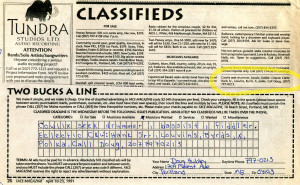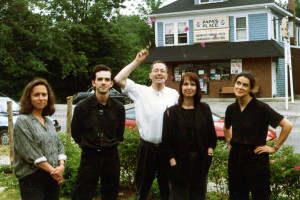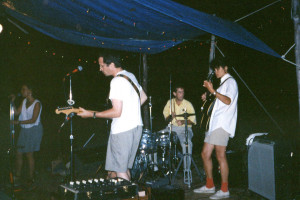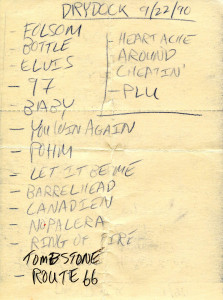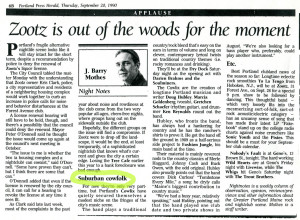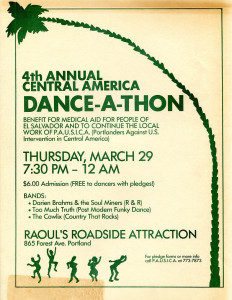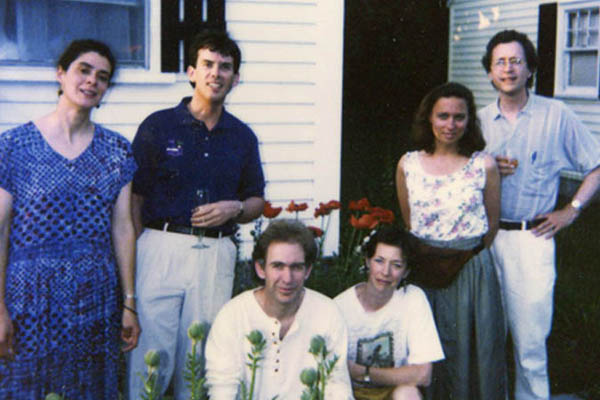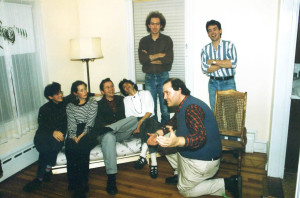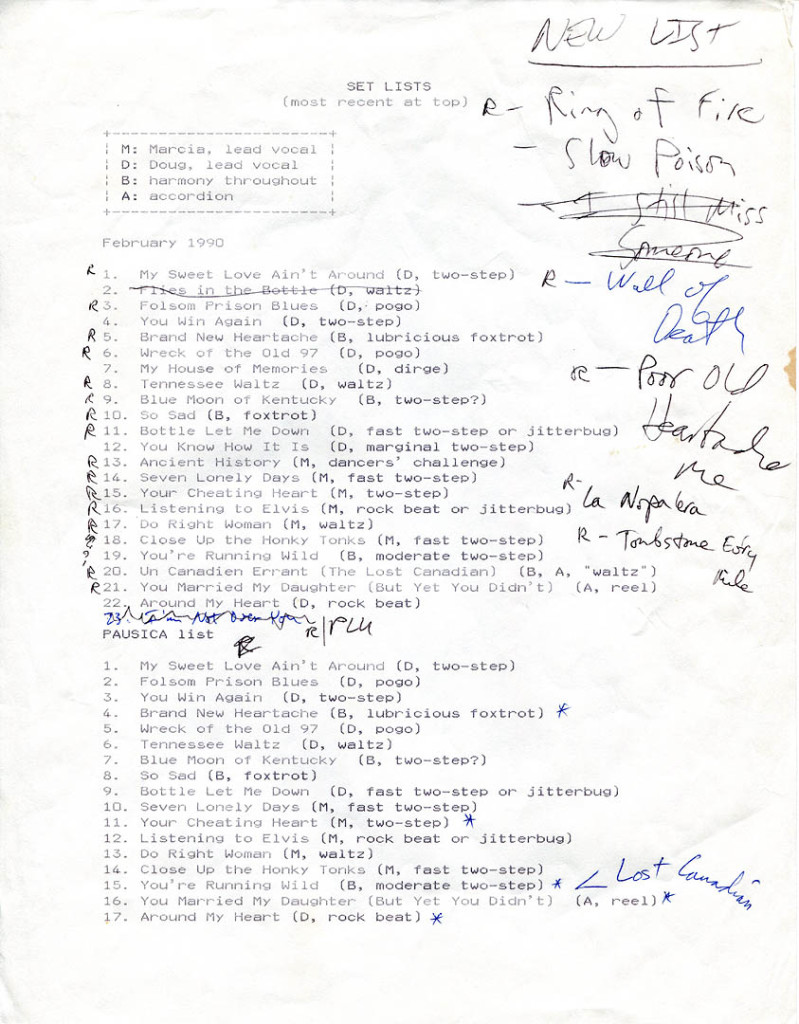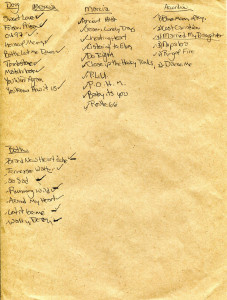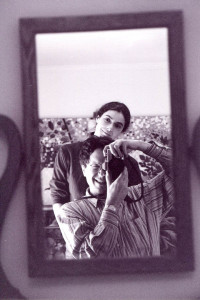Cowlix All Over
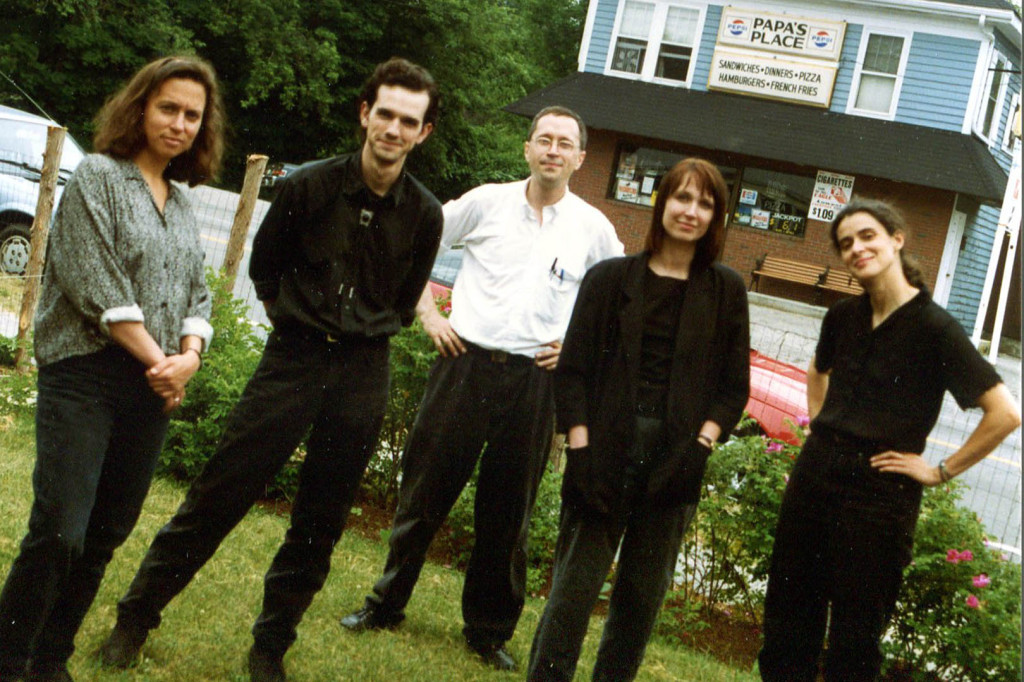
The Cowlix after a gig for Ken Reynolds’ family in 1992. From left, Marcia Goldenberg, Jonathan Nichols-Pethick, Doug Hubley, Melinda McCardell, Gretchen Schaefer. The hand placements are interesting. Photograph by Alden Bodwell/Hubley Archives.
- Never mind wordy words! Go straight to attractive Cowlix rhythms!
- See a gallery of Jeff Stanton images from a 1992 Cowlix performance.
A prepositional exploration of the Two Big Years of the Cowlix, 1992–94.
Part I: All In
Why wait any longer for the bass player you want, when she’s standing in front of you?
— After Bob Dylan
After Ted Papadopoulos left the Cowlix, in late 1991 after several months and two gigs, rhythm guitarist Gretchen Schaefer agreed to learn bass.
For Gretchen, singer Marcia Goldenberg and me, this ended an on-and-off, two-year search that began with Steve Chapman’s departure in 1989 and careened through a wacky succession of bassy contenders. These included a teenager whose amp consisted of a bare chassis with wires sticking out all over it and an apparent crystal meth user who, backing Gretchen and me into a corner of our basement, maniacally insisted that we were all Nashville-bound.
“That time was a transitional guitar-playing period for me,” Gretchen says. “I hadn’t settled into any particular thing that I was comfortable with. So moving to the bass wasn’t a big wrench.
“I liked it. I liked the sound of the different parts that I would play, they had their own sort of melodic sense that was enjoyable. And the plucking came pretty naturally, because I’d done a lot of fingerpicking back in the day.”
Jonathan and Nancy Nichols-Pethick had already planned their journey when he responded to the ‘Lix ad for a drummer. When the time came to announce his departure, “I felt so utterly sick at the thought of telling you about it that I considered just vanishing,” he says — “letting you forever wonder, ‘Whatever happened to that kid who played drums with us?’ But I sucked it up.”
At the time, we weren’t sure if Jonathan would return or not. We didn’t count on it, anyway. But with founding Cowlix drummer Ken Reynolds out of the picture once and for all by winter 1992, we were delighted to welcome the kid back despite all. Twelve years younger than Gretchen and I, he came from California and a musical background in bar-band rock, including stints in Portland with Jenny Woodman and a band called Split 50.
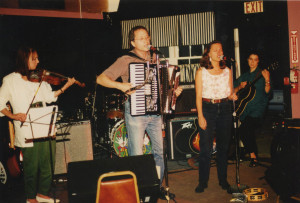
The Cowlix front line during the 1992 opening gig for the Moxie Men at Norton’s in Kittery. From left, Melinda McCardell, Doug Hubley, Marcia Goldenberg, Gretchen Schaefer. Not visible is drummer Jonathan Nichols-Pethick. Photo by Jeff Stanton.
With the Cowlix, “I loved playing these songs I had known only peripherally at best and having to figure out how to do something other than slam my snare on 2 and 4,” he says. “Plus, I just liked hanging out with you all.” Jonathan was a melodic drummer. He made choices that somehow, on some subliminal level, supported more than the beat.
And he and Gretchen quickly found each other’s wavelength, forming a rhythm section that was one of the best things about the Cowlix. “I did feel that mutuality with Jonathan a lot, which was very fun,” says Gretchen. “He was a lot more attuned to that than I was initially, and then by the time I got my playing together enough to actually think of more than just my own concerns, it was really enjoyable.”
It’s something I haven’t thought about till now, but Jonathan was the first drummer I worked with since Ken, with whom I had first played in 1977. And Jon and Gretchen formed the first stable bass-and-drums pairing I had worked with since Ken and Steve.
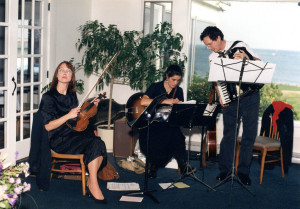
Cowlix gone rogue: Melinda, Gretchen and Doug playing obscure folk music at a wedding in October 1993.
Part II: All Over the Map
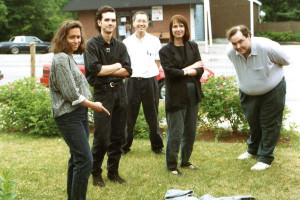
Gretchen took this image of four ‘Lix with our longtime friend and roadie Alden Bodwell. Hubley Archives.
The band that followed my seven years with the Fashion Jungle, the Cowlix started out as a country band, but soon busted out of that corral. That’s largely on me. It took me 30 years, from the Curley Howard Band to today’s Day for Night, to learn the virtues of truth to genre, as opposed to the pleasures of stylistic promiscuity.
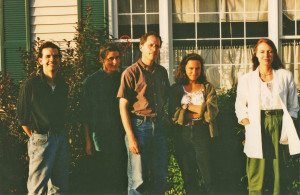
The Cowlix at Norton’s, summer 1992: Jonathan Nichols-Pethick, Gretchen Schaefer, Doug Hubley, Marcia Goldenberg and Melinda McCardell. We opened for the Slaid Cleaves and the Moxie Men. Photo by Jeff Stanton.
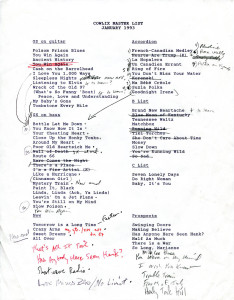
The Cowlix’ master repertoire list in 1993. “Nadine”? Yep, and with accordion,too. Chuck, is that you? Hubley Archives.
We even billed our material as “Country & Eastern” music, the latter descriptor inspired both by our Atlantic sensibilities and by “Linda, Linda” — whose lyrics are in Hebrew and Arabic, which I learned phonetically. (I still don’t know what that song is about.)
This rampant eclecticism “was a lot of fun,” Gretchen says. But, she continues, “I felt doubtful that we connected especially well with audiences because of that.
“Maybe I’m wrong, but I think that music-goers often go for one particular style. I don’t think we were very easily pigeonholed, and I think that was perhaps a detriment in the commercial sense.
“But it was very fun to play all those different things, and it was challenging to try to get a different feel for them.”
Part III: Over and Out
If all the preceding blather about being eclectic sounds familiar, it ought to. Something else that didn’t occur to me at the time, but sticks out now like a sore thumb, was how closely the Cowlix resembled a previous band of mine, the Mirrors. Some of the similarities are superficial. Both bands, at their commercial peaks, had five members. Violin figured prominently in our sounds. I revived several Mirrors songs for the Cowlix repertoire.
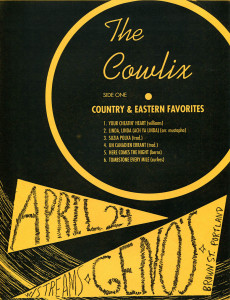
The product of my semester in a graphic design course in 1992, this poster template served us well for a year or two. Hubley Archives.
And I’m glad I don’t have the Porthole on tape. I don’t want to sully that memory with documented reality. I do have plenty of Cowlix on tape, and it has taught me, first, that someone should have taken my digital-delay pedal away until I learned how to use it; and second, that my lead guitar playing was worst on the country music to which we had, however waywardly, pledged our troth.
This somehow brings me to the Mirrors-Cowlix similarities that struck deeper. One is very simple. Both bands started out congenially, united by excitement about the music and the promise of our shining goals. And in both cases, as our musical machine proved itself and our goals were met or reconsidered or just dropped, the fundamental chemistry went wrong. Marcia left the Cowlix in March 1994, after more than four years with the band. Melinda followed her out the door in May.
Then, of course, there was the eclecticism thing discussed above. Both bands loved musical diversity not wisely but too well. And in both cases, after a certain point, what started out as carefree boundary-busting exploration coalesced into something else altogether: the potential for a new direction and new energy that could be consummated only with the band that followed. For Gretchen, Jonathan and me, that band was the Boarders.
Hear six songs by the Cowlix, four original and two in the public domain. Although the Cowlix’ founding premise was a faithful, if slightly ironic, take on the classic country catalog, this successor band to the Fashion Jungle went rogue pretty much at the outset. A given ’Lix set could represent Merle Haggard, the Louvin Brothers, Patsy Cline, Buck Owens, X, David Lindley, Québécois and Polish folk songs, Syd Straw, Nick Lowe . . . you get the idea. We were essentially a covers band in the literal sense, if not with the bar-band implications that come with that term. Padded out with two folk songs in the public domain, this set contains virtually all the original material we ever did (“Shortwave Radio,” not represented here, popped up late in the Cowlix’ run). Personnel: Marcia Goldenberg, vocals and rhythm guitar; Doug Hubley, vocals, lead guitar and accordion; Melinda McCardell, violin; Jon Nichols-Pethick, drums; Gretchen Schaefer, bass and rhythm guitar.
- All Over (J. Nichols-Pethick–D. Hubley) “It started, obviously enough I suppose, while I was drinking a beer and noticed my reflection in the glass,” recalls Jonathan, whose song this essentially is. “‘That’s kind of poetic,’ I thought, ‘in a country sort of way. I should try to write a song that incorporates that.’ . . . I started playing around with the phrases and came up with ‘It’s all over now and it’s all over town.’ I thought that had the requisite wordplay that I had come to admire about good country songs and I went from there.” In a version much different from ours, this later turned up in the repertoire of Scott Link’s band Diesel Doug & the Long-Haul Truckers, and appeared on their first CD. The recording was made at Tree Frog, a professional studio in Buxton, in early 1994, just before the Cowlix ceased to be. Copyright © 1992 by Jonathan Nichols-Pethick and Douglas L. Hubley. All rights reserved.
- Slow Poison (Hubley) I wrote “Slow Poison” early in the Cowlix’ run, in 1990, aiming for an Everly Brothers kind of thing. It was beyond my reach. In fact, I concluded that I could never write like that and, since we were performing so much country music that I felt unable to match, I stopped trying for a few years. We fooled around with “Slow Poison” (it was a slow foxtrot at first), tabled it, finally solidified it in 1992. This performance was recorded at the Maine College of Art 1992 Halloween Party, held in the Baxter Building in downtown Portland. This song lives on once again in the Day for Night repertoire with a nice through-harmony. Copyright © 2010 by Douglas L. Hubley. All rights reserved.
- Un Canadien Errant (Antoine Gérin-Lajoie) Lamenting the misery of exile, this French-language number was written in 1842 by a French Canadian man following the Lower Canada Rebellion of 1837–38. I heard it first by Leonard Cohen (who recorded it in a mariachi style, of all things) and later by Ian & Sylvia, among other folksingers. This early Cowlix selection was also one of the most durable in our repertoire. This is a rehearsal recording from 1992.
- You Know How It Is (Hubley) As with Amtrak and train songs, great country lyrics are not waiting to be written about the work of a press-release writer at a small elite college. It was much easier to complain in song about working in the stockroom at the Jordan Marsh department store, which I was doing in 1978 when I wrote this. Even the title makes a virtue out of banality. This song started with the Mirrors and came back for the Cowlix. Recorded at the Murrays’ barn dance, August 1993. Copyright © 2010 by Douglas L. Hubley. All rights reserved.
- Trouble Train (Hubley) There used to be a sign at the Androscoggin River in Topsham, Maine, that warned visitors to the riverbank that the water could rise suddenly due to operations at the nearby hydroelectric dam. That sign inspired this song, which is less a train song than a collection of metaphors for trouble. Another Tree Frog recording. Copyright © 1994 by Douglas L. Hubley. All rights reserved.
- Wieczorna Róza-Waltz (Vitak-Elsnic Co.) Back in the ’80s, when I was first torturing the accordion (and any listeners in the vicinity), a member of the Delux Productions troupe lent me a funny little book of contrived Polish “folk” music. Hence this waltz. This excerpt comes from a Cowlix date at the Murrays’ barn dance, August 1993.
“Notes From a Basement” text copyright © 2014 by Douglas L. Hubley. All rights reserved.












